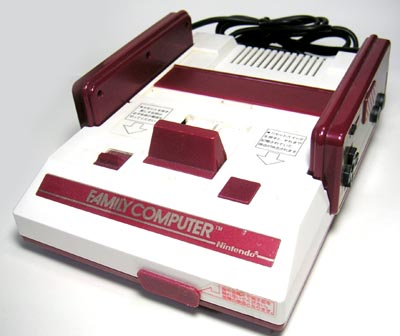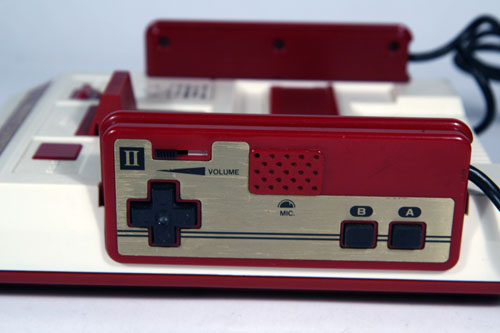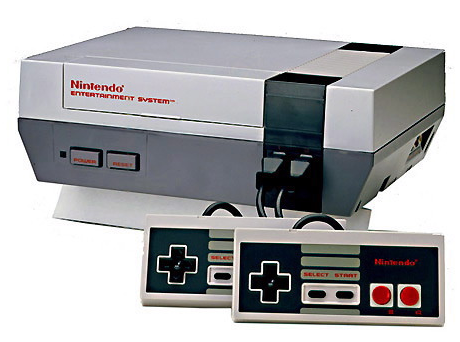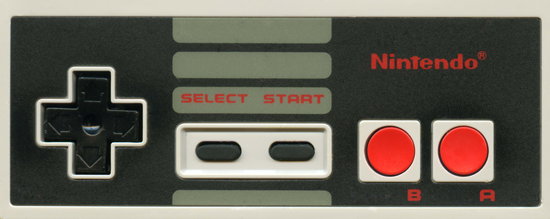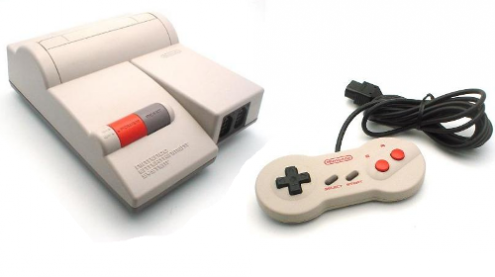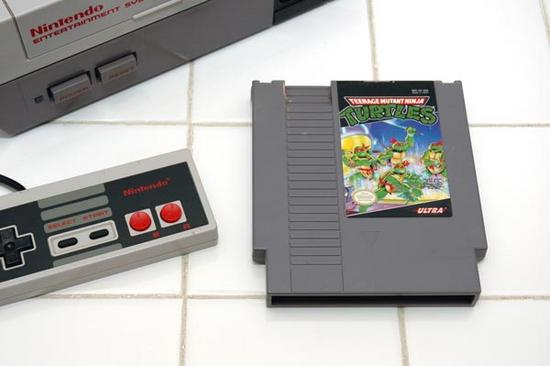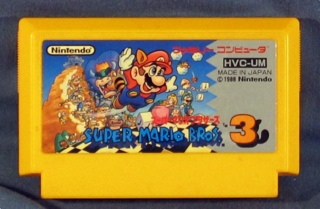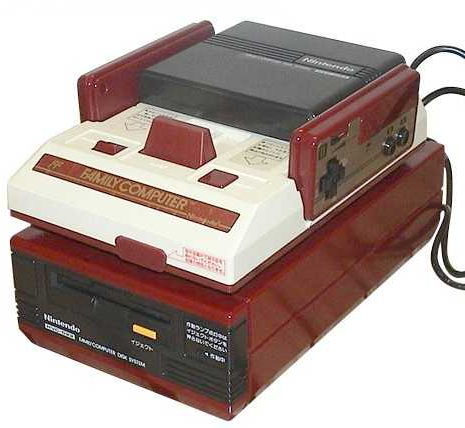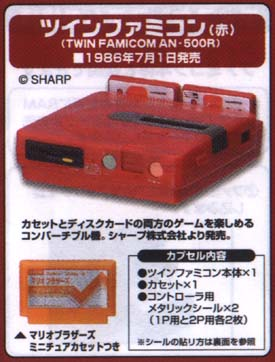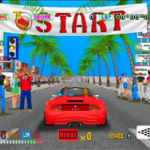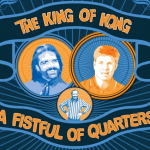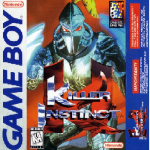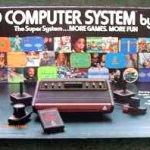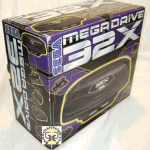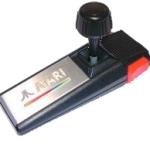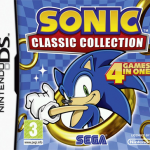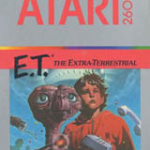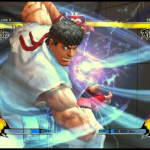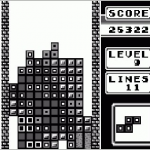The Nintendo Entertainment System is an 8-bit console which is credited as revitalising the North American video games industry in the mid 80s. It was the best selling video games console in history at the time, selling over 60 million units worldwide.
It was known as the Famicom in Japan, the Hyundai Comboy in South Korea, the Dendy in Russia and Tata Famicom in some parts of Asia. Though in most parts of the world it was marketed as the Nintendo Entertainment System (or NES for short).
It was released in Japan in 1983, the United States in 1985, Canada and parts of Europe in 1986 and the rest of the world the following year. It didn’t take long for the console to establish itself as the number 1 console in each territory it was released. This was achieved through the many ‘killer apps’ which the console launched with: like Donkey Kong, Kung Fu, Duck Hunt, and Super Mario Bros (the best selling game of all time until Wii Sports arrived). Later games such as Super Mario Bros. 3, Metroid, Contra, The Legend of Zelda, and Mega Man 2, helped keep Nintendo on top for several years.
The console was released in Japan with a red and white design. The cartridge was loaded onto the top of the console with an expansion port at the front.
The controllers were hard wired to the console, being marked I and II respectively. A digital D-Pad was chosen instead of a paddle or a joystick, which most other consoles used at the time. It proved to be so popular, the D-Pad has been used on nearly all major game console controllers every since.
In 1983 the Famicom was released with controllers with square A and B buttons. Controller I had a start and select button for selecting and pausing games whilst controller II had a microphone built in (which was used by some early games).
After many Famicoms were recalled in 1984, the controller was updated with the circular buttons which most people came to know and love.
In the western world the system Nintendo Entertainment System was released with a different design from it’s Japanese counterpart, with the red and white colour scheme being replaced by a combination of light and dark grey.
The console featured a front loading cartridge slot rather than simply connecting them at the top.
The NES controllers were different from the Famicoms. They were no longer marked I and II and both controllers were now identical and had select and start buttons on each controller. As a result, the microphone was removed from the 2nd controller.
Most importantly, the controllers were no longer hard wired to the system itself. These new detachable controllers had 6 feet long cables, which meant that users didn’t have to sit as close to the system itself. It wasn’t until the launch of the New Famicom (HVC-101) in 1993 that Nintendo made the Famicom controllers detachable as well, but for some reason they limited the cable length to 3 feet (perhaps there was a cable shortage that year!).
You only need to look at some of the awful game controllers which were released in the 70s and early 80s to appreciate how good the NES controllers were (and still are).
Specifications
The NES uses a a variation of the 8-bit MOS Technology 6502 CPU. The chip was produced by Ricoh, who were willing to produce the chip at a budget price on the promise of a 3 million sales order (even though Nintendos Color TV Game had only sold about a million units).
In North America and Japan Nintendo used the Ricoh 2A03 chip, which was clocked at 1.79 MHz. In PAL territories (Europe/Australia etc) the chip was clocked at 1.66 MHz (and was known as the Ricoh 2A07).
The console had 2kb of RAM, 2kb of VRAM and 32kb of ROM, which could be expanded using bank switching. Ricoh also produced the graphics chip for the NES. The Ricoh Picture Processing Unit RP2C02 had a speed of 5.37 MHz (Pal version used the RP2C07 which was the same chip but clocked at the slower speed of 5.32 MHz). Games could display 48 colours (+5 greys) at a resolution of 256×240 pixels.
The NES had 5 channels of sound. Most systems in the early 80s only offered 2 or 3 channels, which helped NES games sound closer to arcade standards than the other consoles at the time,
All systems included a 10NES authentication. This chip ensured that the cartridge being inserted was officially licensed by Nintendo. Though many companies found ways of getting around this.
Variations
In 1993 Nintendo released an updated version of the NES in North America called the NES-101, retailing for $49.99. Nintendo marketed it as the Nintendo Entertainment System but most people referred to it as the NES2.
The first NES (model NES-001) was affectionately known as the ‘Toaster’ because of the front loading cartridge slot. This new model was sometimes referred to as the ‘Top Loader’ since the cartridge slot had been placed on the top, much like the Japanese Famicom. The top loading cartridge slot was chosen because of the problems the original cartridge system caused (amongst other things, dust was a big problem).
The new design was much slimmer too though the hardware inside was much the same, except for the removal of the 10NES authenticity chip. They also removed composite cable connectibity.
The controllers got a makeover too, resembling a SNES joypad without as many buttons.
Japan saw the release of a new Family Computer just a few months after the NES2 was launched in North America. It’s model number was HVC-101 though most gamers referred to it as the New Famicom or AV Famicom.
The console looked identical to the NES2 though in the Japanese version the RF output was replaced with AV cables. This was the first time Famicom controllers had not been hard wired to the console itself.
Cartridges
The design of the NES cartridge was different in Japan (and most of Asia) than the rest of the world. In North America and Europe the cartridges 5.25 inches in length, 4.75 inches in width and 0.75 inches in depth.
The Legend of Zelda and it’s successful sequel Zelda II: The Adventure of Link, came in gold coloured plastic. However, every other official game released in this region came in a standard grey colour. A few unofficial games had a different colour though (for example, unlicensed games from Tengen were usually in black).
In Japan the Famicom cartridges were much smaller and much more colourful too. The cartridges were 4 inches in length and 5.3 inches in width and came in a large range of colours. Check out Famicase to see pictures of many of the weird and wonderful designs which were released for the Famicom in Japan
The cartridges used a different number of pins to connect to the system too. In North America and Europe the larger grey cartridges used 72 pins, whereas in Japan the smaller cartridges used 60. Interestingly, the first games to be released in the USA had 60 pins and were built with a converter within the cartridge in order for them play in the top loading NES.
History
It was originally released in Japan 1983 as the Family Computer, or Famicom for short. The first games available were all ports of Nintendo arcade games: Donkey Kong, Donkey Kong Jr., and Popeye. Unfortunately, the first batch of consoles had to be recalled due to problems with the motherboard but within a year it had established itself as the best selling console in Japan.
Nintendo then started looking at breaking the lucrative North American market. At the time the Atari 2600 was the best selling console in the USA so Nintendo spoke to Atari about releasing the NES under the Atari brand, with the system to be called the Nintendo Advanced Video Gaming System but negotiations broke down.
They then looked into releasing the Nintendo with a keyboard and cassette recorder as the Nintendo Advanced Video System, but that never came to fruition either.
They finally unveiled their new system at the Consumer Electronics show in 1985. The name had been changed to the Nintendo Entertainment System for Western consumers, though it was commonly abbreviated to the NES. After testing the system out in a few localised areas in the USA, they launched the NES on February 1986.
Since the Famicom had been out for a few years in Japan, they were able to launch the NES in North America with a whopping 18 titles. The launch titles were 10-Yard Fight, Baseball, Clu Clu Land, Donkey Kong Jr. Math, Duck Hunt, Excitebike, Golf, Gyromite, Hogan’s Alley, Ice Climber, Kung Fu, Mach Rider, Pinball, Stack-Up, Super Mario Bros, Tennis, Wild Gunman, and Wrecking Crew.
The NES was later released in most of Europe later that year with parts of Europe and Australasia getting the NES in 1987. Until 1990, Mattel handled distribution in the UK, Ireland and Australia. However, Nintendo then consolidated their European efforts and handled all distribution themselves.
A major peripheral that never saw life outside of Japan was the Famicom Disk System. It was released in Japan in early 1986 was sold right up until the Famicom was discontinued in 2003. The add on had sales over 4.5 million, which illustrates how popular it was in Japan.
The floppy disks were 2.8 by 3 inches and contained 112kb of memory in total (56kb each side). The system connected to the NES though had to powered by battery or by it’s own AC adaptor.
Many early games in Japan (such as Metroid) utilised the disk system in order to save games. Unfortunately, the disks were easy to copy so piracy was very common, though perhaps this was a reason why the system was so popular in the first place. Like many floppy disks, the Nintendo disk cards were also known to stop working if dust got in them.
Also released in 1986 was the Twin Famicom, a machine by Sharp which put the Famicom and the Disk System in one unit. It was released in a variety of colours.
When games which utilised the disk system for saving games were released in North America, they were released with a battery in order to save the games progress. Apparently Nintendo announced that the disk system was going to be released in North America but it was never was. Perhaps they had concerns about the level of piracy which was prevalent in Japan.
In the late 80s and early 90s the NES was at it’s peak. Soime of the systems best games came out during this period. Though the release of the Sega Megadrive (Genesis) worldwide between 1988 and 1990 and Nintendos own successor the Super NES between 1990 and 1992 saw millions of their users switch to a next generation console.
Eventually the NES was discontinued in 1995 in North America but it wasn’t officially discontinued in Japan until 2003, making it’s official lifespan a whopping 20 years.
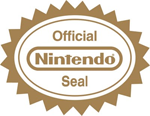 One major thing Nintendo changed with the NES was licensing laws. Atari had did everything they could to stop 3rd parties from developing games for their 2600 system but Nintendo welcomed it, albeit on their terms.
One major thing Nintendo changed with the NES was licensing laws. Atari had did everything they could to stop 3rd parties from developing games for their 2600 system but Nintendo welcomed it, albeit on their terms.
Every NES console had a 10NES authentication chip inside it and every game had one too. Games which hadn’t been licensed but not load. Customers could tell licensed games because they had the Nintendo Seal of Quality plastered over the case. Nintendo also made 3rd party developers sign exclusive contracts with them so that they could only produce games for Nintendo. This was not popular with many games companies.
Some companies, like Tengen, did find a way around this authentication system and released a number of games on the NES. Nintendo took many of these companies to court.
The NES has left behind a wonderful legacy. It is credited as kick starting the failing video games market in North America in the 80s, it’s simple controller became the basis for all future controllers and it set the standard for 3rd party games licensing.
Videos
The first commercial for the NES in the USA.
100 NES (Nintendo) games in 10 minutes!
My NES Collection – The Angry Video Game Nerd shows off his impressive collection of NES games.
Scary NES Commercial
Nes commercial – Nintendo ToysRus
Emulation
There are dozens of great NES emulators available which allow you to play old old NES games. ROMS for the majority of games which were released are freely available.
Popular Emulators
- Nesticle – A Dos based emulator.
- JNes – A popular emulator which uses DirectX.
- UberNes – A Windows emulator which uses DirectX.
- Nintendulator – A Win32 NES emulator.
- RockNes – Works with Windows and Dos.
- FCEUX – Works with Linux and Windows.
- NesTopia – Works with Windows, Linux and Mac.
- NesTen – Windows based emulator.
- MarioNES / 80five – A good emulator. 80five is the latest incarnation of the script.
- fwNES – Another popular emulator.
- NesterJ – Another Windows based emulator.
- FakeNES – An open source NES Emulator.
NES ROM Archives
Legal View
Please be aware that it is illegal to play an old NES game in this way. It was widely believed for years that it was perfectly legal if you owned the original cartridge for the game though this has been rejected by Nintendo.
Here is an excerpt from their legal information page:
Can I Download a Nintendo ROM from the Internet if I Already Own the Authentic Game?
There is a good deal of misinformation on the Internet regarding the backup/archival copy exception. It is not a “second copy” rule and is often mistakenly cited for the proposition that if you have one lawful copy of a copyrighted work, you are entitled to have a second copy of the copyrighted work even if that second copy is an infringing copy. The backup/archival copy exception is a very narrow limitation relating to a copy being made by the rightful owner of an authentic game to ensure he or she has one in the event of damage or destruction of the authentic. Therefore, whether you have an authentic game or not, or whether you have possession of a Nintendo ROM for a limited amount of time, i.e. 24 hours, it is illegal to download and play a Nintendo ROM from the Internet.
How Does Nintendo Feel About the Emergence of Video Game Emulators?
The introduction of emulators created to play illegally copied Nintendo software represents the greatest threat to date to the intellectual property rights of video game developers. As is the case with any business or industry, when its products become available for free, the revenue stream supporting that industry is threatened. Such emulators have the potential to significantly damage a worldwide entertainment software industry which generates over $15 billion annually, and tens of thousands of jobs.
What Does Nintendo Think of the Argument that Emulators are Actually Good for Nintendo Because it Promotes the Nintendo Brand to PC Users and Leads to More Sales?
Distribution of an emulator developed to play illegally copied Nintendo software hurts Nintendo’s goodwill, the millions of dollars invested in research & development and marketing by Nintendo and its licensees. Substantial damages are caused to Nintendo and its licensees. It is irrelevant whether or not someone profits from the distribution of an emulator. The emulator promotes the play of illegal ROMs , NOT authentic games. Thus, not only does it not lead to more sales, it has the opposite effect and purpose.
How Come Nintendo Does Not Take Steps Towards Legitimizing Nintendo Emulators?
Emulators developed to play illegally copied Nintendo software promote piracy. That’s like asking why doesn’t Nintendo legitimize piracy. It doesn’t make any business sense. It’s that simple and not open to debate.
People Making Nintendo Emulators and Nintendo ROMs are Helping Publishers by Making Old Games Available that are No Longer Being Sold by the Copyright Owner. This Does Not Hurt Anyone and Allows Gamers to Play Old Favorites. What’s the Problem?
The problem is that it’s illegal. Copyrights and trademarks of games are corporate assets. If these vintage titles are available far and wide, it undermines the value of this intellectual property and adversely affects the right owner. In addition, the assumption that the games involved are vintage or nostalgia games is incorrect. Nintendo is famous for bringing back to life its popular characters for its newer systems, for example, Mario and Donkey Kong have enjoyed their adventures on all Nintendo platforms, going from coin-op machines to our latest hardware platforms. As a copyright owner, and creator of such famous characters, only Nintendo has the right to benefit from such valuable assets.
Links
- Famicom World – A great site about the Japanese Famicom.
- NES Files – Manuals, screenshots and instructions of hundreds of NES games.
- VirtualNes – Play all your favourite games online with a flash emulator.
- The Good, The Bad & The Ugly – A look at some of the weird Nintendo branded products that have been released over the years.
- ClassicGaming Museum – A summary of the Nintendo Entertainment System.
- Nintendo Daily – Another good NES fan site.
- NES Buckle – The original NES belt buckle.
- Nintendo Entertainment System Mouse – A concept retro mouse based on the original NES controller.
- NES Guide – A great archive of all NES games.
- NESPlayer – A good NES fan site.
- NintendoAge – Information about pretty much every NES game ever released.
- PlayNes – Web based NES Emulator.
- RoyalRanger’s NES Site – A fan site which hasn’t been updated since 2003 though it’s worth checking out as there’s some good articles still hosted there.
- World of Video Games – An old site which hasn’t been updated since way back in 2000 but there is some great info there.
- Retro NES USB Controller – A great USB controller to play classic NES games.
- Entertonement – Over a thousand sound bites from classic NES games.
- NerdTracker II – MS-DOS program which lets you recreate NES and Famicom Music.
- NESDev – Tools for programmers to make NES Games.
- Moby Games – Screenshots and basic info about all NES games.
- NESWorld – Fantastic NES fan site.
- World Of Everything Nintendo – Dedicated to everything NES.
- Sears Catalogue Scan – A scan of a Nintendo advertisement from 1988.
